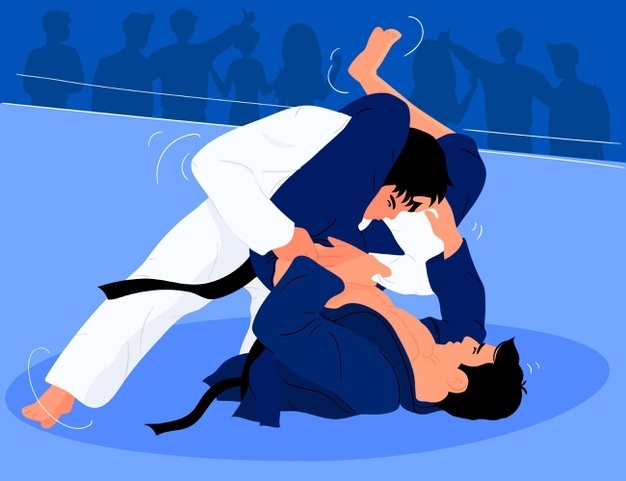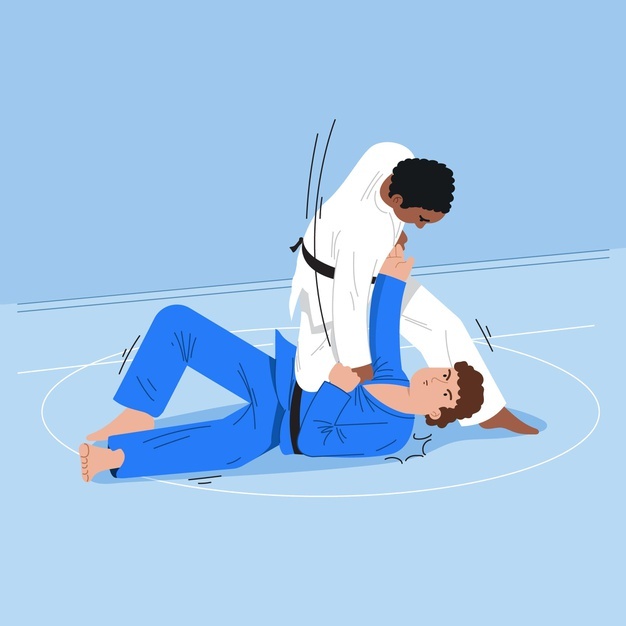
By now, you’ve probably heard a lot about how Jiu-Jitsu has become one of the most popular martial arts. But what exactly is Jiu-Jitsu? What makes it distinctive from other martial arts? And why should you start training?
Before we dive into why you should be practicing BJJ, we first must talk about what Jiu-Jitsu is.
Understanding Jiu-Jitsu
Jiu-jitsu is a martial art that started in Japan and is now practiced all over the world.
While the history of jiu-jitsu is ancient, it wasn’t officially created until the 19th century.
The term “jiu-jitsu” is a combination of two Japanese words: “Ji” meaning “gentle” and “Ju” meaning “art.” The word “judo” means something like “gentle way” or “way of soft art.”
The style we know today as jiu-jitsu originated from Kodokan Judo, which was practiced in Japan and contributed to the development of judo.
In the early 1900s, Jigoro Kano, a Japanese Judo master, decided to adopt this martial art to the needs of the samurai warriors, who had become weaker and less agile after the Meiji Restoration.
Kano adapted judo techniques to make jiu-jitsu more effective for the weaker, smaller fighter.
He developed groundwork techniques involving pinning an opponent to the ground using grappling holds, such as the lapel, wristlock, and back take.
He also incorporated chokeholds, such as the shoulder lock, the kimura, and the Americana.
Today, jiu-jitsu is practiced worldwide, including in the U.S., Brazil, Europe, South Africa, and Japan.
Mixed martial arts (MMA) is a popular sport where the Brazilian Jiu-Jitsu style is dominant.
The origins of modern MMA were linked to demonstrating the combat efficiency of Brazilian Jiu-Jitsu.
But Brazilian Jiu-Jitsu as a sport is distinct from MMA. No kicking or punching in daily lessons. The emphasis is on a safe grappling method that you may do every day without risk of harm.
The Art of Jiu-Jitsu
The art’s name means “gentle art” and is attributed to its founder, Jigoro Kano. The art’s roots are in Japan, but nowadays, it’s practiced worldwide.
There are dozens of different Jiu-Jitsu styles, and the name “Jiu-Jitsu” applies to many of them. Some techniques utilize both dominant and non-dominant hands so that you can take up jiu-Jitsu at any time during your life.
Practitioners neutralize an opponent using pins, joint locks and throw by turning an attacker’s energy against him instead of directly fighting it (as with other martial arts such as karate)
There are five major areas or skills of training:
- Blocking
- Fulcrum throw
- Non-fulcrum throw
- Evading
- Striking
The art focuses on self-defense, which means that its practitioners are more like athletes than martial artists, so Jiu-Jitsu fighters compete.
The competitions that take place are known as “jiu-jitsu matches.”
The matches consist of two competitors, each trying to gain control of the other.
Most Jujutsu schools teach weapon techniques, such as knives, sticks, canes, small swords, chokes, and ropes.
When utilized properly, it is possible to disarm an adversary and remove a weapon. Numerous Jujutsu students have received training in healing methods, CPR, footwork, and massage.
People practice Jiu-Jitsu for many reasons, but the ability to defend oneself is always top on the list. It is also a way for people of all genders to express themselves and work out aggression.
Today, Jiu-Jitsu is mainly practiced as a sport, and it’s expected to be a part of the Olympics in 2020. Despite the sport component of BJJ, the art’s roots are in self-defense, and it’s still used for that purpose today.
Different Belt Levels in Brazilian Jiu-Jitsu
In the early days of martial arts, instructors only used belts to identify what rank they were. Martial artists were free to wear whatever they wanted, but, in those days, straps were not for style or rank.
Nowadays, belts are used to identify levels of accomplishment in both martial arts and life. If you want to measure your progress in martial arts, you wear a belt. If you’re going to measure your progress in life, you wear a belt.
Belts are worn by martial artists of all ages, from young children to senior citizens. They start as white belts and progress through the belt system until they earn black belts.
Adults in BJJ have eight belt levels:
- White belt
- Blue belt
- Purple belt
- Brown belt
- Black belt
- Red and black belt (7th-degree black belt)
- Red and white belt (8th-degree black belt)
- Red belt (9th and 10th-degree black belt)
As for Youngsters, there are 13 belts available.You find a detailed explanation here: BRAZILIAN JIU-JITSU BELT RANKING
6 Reasons Why People Practice BJJ
Compete
Jiu-Jitsu is an Olympic sport, and competition is a massive part of the sport. Competitions feature several competition divisions, including adult, cadets, kids, masters, and women’s divisions.
The trend of the sport has soared in recent years; in 2016, it was added to the Olympic Games in Rio de Janeiro.
Train
Competitors use martial art training such as Muay Thai and BJJ to keep in shape, learn self-defense techniques, and test their skills against their opponents.
They train to improve their tactic, skills, learn new strategies, and master techniques to achieve their goals.
Learn
BJJ also values education. In addition to teaching self-defense systems, competitors learn valuable life lessons.
Bond with Family
BJJ is a family affair. It is the best way for kids to learn essential life lessons.
Competitions require kids and their parents to work as a team.
Challenge
Jiu-Jitsu challenges people of all ages and skill levels. People enjoy the challenge of learning new techniques and strategies.
Learn New Principles
Training Brazilian Jiu-Jitsu helps you concentrate on the broader picture. Nothing scares you now.
Where can you find a class to practice?
BJJ classes can be intimidating, so choosing a martial arts school that cares about helping you feel comfortable and succeed is important. Pinnacle Martial Arts Academy (PMAA) in Monroe, Louisiana, offers a friendly, welcoming environment that caters to various skill levels.
PMAA offers several jiu-jitsu classes, including beginner, intermediate and advanced. Classes are offered five days a week.
Kid’s classes are also available.
Pinnacle Martial Arts Academy offers kickboxing(Thai Kickboxing), Mixed Martial Arts (MMA), Kid’s Martial Arts, Teen’s Martial Arts, Wrestling, and Judo. Choose your program today!
Learn Brazilian Jiu-Jitsu Today!
Practice the art of Jiu-Jitsu. Learn how to defend yourself, engage in a healthy lifestyle that incorporates fitness and exercise, and achieve the skills needed to avoid danger and create opportunities for yourself. The six main reasons why this martial art is worth your time. It’s the time of your life to get started! Get in shape and learn Brazilian Jiu-Jitsu. Visit Pinnacle Martial Arts Academy today!

